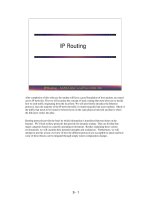Tài liệu Strange bedfellows pptx
Bạn đang xem bản rút gọn của tài liệu. Xem và tải ngay bản đầy đủ của tài liệu tại đây (284.2 KB, 3 trang )
Telephony • September 11, 2000 • www.internettelephony.com
With so much growth and change taking
place, and given the complications of build-
ing a network, it’s not surprising that service
providers seek simplicity wherever they can
find it.And with so many changing technolo-
gies to consider, industry players might mis-
takenly relegate powering equipment to the
“no-brainer” category.
The truth is, without thorough planning,
power easily can become the weak link in the
chain of devices needed for successful service
delivery. Providers that simply replicate old
powering formulas in a new environment,
leave powering decisions to vendors or put
off consideration of power issues until the
last minute could be placing themselves,their
networks and even their market shares and
revenue streams at risk.
In business, even seemingly minor tech-
nical decisions can have larger implications.
The question isn’t just, “How does this com-
ponent function in a network?” but also,
“How does it affect our profitability?” The
reason is that even a profitable operation can
be vulnerable to competitive pressure from
more profitable players, and telecommunica-
tions markets are nothing if not competitive.
The more profitable competitor is freer to
cut prices to gain market share or to use prof-
its to fund growth and innovation.Over time,
even small differences in profitability are
multiplied. That’s why every decision should
include considerations of long-term financial
impact, in terms of controlling cost and in-
creasing revenue.
The impact of power
The next time you think of disregarding
power as a critical issue in network design,
think about the last time your lights went out.
Power is a show-stopper. Without it, systems
don’t operate. When it malfunctions, it can
damage other equipment, start fires or injure
people. For myriad reasons, power is not the
place to cut corners. Unfortunately,many ser-
vice providers could be cutting corners with-
out even realizing it.
Service providers should take the time to
examine policies and procedures. They
should make appropriate choices now, codify
them as purchasing specifications and opera-
tional rules, and follow them. Then they can
rest assured that they are not going to be
blindsided by disaster or “nibbled to death”
by small recurrent problems that could have
been prevented by incorporating the appro-
priate power solution into the network.
In today’s deregulated markets, an in-
creasing number of service providers are de-
livering both voice and data services.The dif-
bedfellows
As deregulation’s effects broaden,ILECs and
CLECs are finding themselves in increasingly
close quarters
Strange
by DAVID SCHOMAKER
I
f, in this political season,you are reminded that politics makes strange bedfellows, consider that deregulation
makes even stranger ones.Not only are voice and data converging, but,in the process,incumbent and compet-
itive carriers are literally becoming roommates, sharing facilities in central offices and remote locations as
mandated by the FCC.It may not be a match made in heaven,but it is part of a market explosion that could be
rewarding for all involved.
®
Telephony • September 11, 2000 • www.internettelephony.com
ferent types of equipment supporting these
two types of service have little in common,
including their amperage requirements.
Telephony gear typically has required
GMT fuses with capacities of up to 15 A. Data
gear such as routers, DSL access multiplexers
and DSL interfaces are more likely to use
KLM fuses (up to 30 A) or even TPA fuses (up
to 50 A) or panels housing high-amperage
circuit breakers.
Then there’s the matter of shared facili-
ties. Deregulation requires incumbent local
exchange carriers (ILECs) to lease certain
areas of their facilities to competitive local
exchange carriers (CLECs). As hosts, ILECs
are setting strict rules governing the shared
facilities; as guests—and to protect their
continued access to the shared facilities—
CLECs would do well to follow those rules to
the letter.
Competition already has been mentioned,
but it is worth repeating. Consider the ease
with which customers can change service
providers. If a service provider disappoints
them, they can be gone before the provider
even knows that there’s a problem. Con-
versely, if a competitor disappoints them, the
incumbent can win their business just as
quickly.To gain and retain customers, service
providers must be able to deliver new ser-
vices quickly and keep them running, come
what may.
Finally, there’s the labor market: It’s tight.
Support personnel are hard to find and ex-
pensive to hire. Service providers might even
have to settle for less experienced people.
Keeping up with a growing workload simply
costs more; getting by on the old budget
could impact service and reduce revenue.
There’s only one way out of the squeeze:
Providers should do anything to eliminate,
speed up or simplify work on their networks.
It will save money and protect their earnings.
Start with standards
Components installed in complex networks
face all sorts of challenges, from heat and hu-
midity to earthquakes. There’s no way a net-
work builder could identify them all, let alone
evaluate equipment for performance under all
circumstances. That’s why panels of seasoned
experts develop standards. Using equipment
that complies with standards will reduce risk.
But for CLECs, there’s another reason to go
with standard-compliant systems. ILECs de-
mand compliance from any equipment in-
stalled on their premises and their networks.
The most critical standard is Network
Equipment Building Standards (NEBS)
Level 3 (Table 1). Full compliance with this
strict standard can only be guaranteed
through independent testing. Vendors that
may not be able to meet the stringent re-
quirements of independent testers may do
their own testing or simply describe compo-
nents as being “manufactured to NEBS
standards.”
The only way for service providers to pro-
tect themselves is to demand independently
tested NEBS 3 compliance, as the ILECs do.
Other standards relevant to power systems
include: UL, NEC (written by the National
Fire Protection Agency), Telcordia (formerly
Bellcore) approval, CSA (Canadian Standards
Association) guidelines, the CE (Conformité
Européenne) mark for installation within the
European Union, and IEC standards (written
by a worldwide body governing public net-
work equipment).
A step beyond
standards
Important as it is, independent NEBS 3 test-
Table 1 NEBS criteria levels
Requirement Level 1 Level 2 Level 3
System fire test and Plastics = 94 V-0 or better
materials/components Components = Agency approved Same Same
Electrical safety GR-1089 Same Same
Listing requirements UL, CSA or ETL Same Same
Bonding and grounding GR-1089 Same Same
EMC/EMI FCC Part 15, CISPR 22 FCC Part 15, CISPR 22 FCC Part 15, CISPR 22
(emissions) (emissions and immunity) Emissions and Immunity
with doors open
Short circuit Tip to ring for 30 minutes Same Same
Lightning immunity 5 KVAC, 2 milliseconds 2.5 KVAC, 10 milliseconds Same as level 2
Current limiting Specify protection device
as required Same Same
AC power fault 600 VAC, 15 minutes 1000 VAC, 300 sec. Same as level 2
Voltage limiting Specify protection device
as required Same Same
Thermal operation 5 to 40 C -5 to 55 C, 5% to 90%
10% to 85% relative humidity relative humidity (operating)
Storage and transportation -40 to 70 C, Drop and
transportation vibration
Earthquake Zone 2 Zone 4
Office vibration GR-63 Same
ESD Operation/install/repair Same
Airborne contaminantes Indoor Outdoor
Steady state power induction GR-1089 GR-1089
Source:ADC
ing checks only a hand-picked product
sample provided by the manufacturer. To en-
sure the same level of performance in the de-
vices a service provider installs, the carrier
must put faith in the consistency of the man-
ufacturing process.
Service providers could monitor the capa-
bilities of the vendor it is considering, but
there is an easier way. They should insist on
ISO 9001 certification.This is an assurance of
quality and consistency in the process and,
consequently, in the product.
And in the manufacturing process, quan-
tity is just as important as quality. All net-
work managers believe in planning ahead,
but in fast-moving markets, that’s often im-
possible. For example, a service provider re-
ceives a large service order and discovers that
its power systems vendor can’t meet the
deadline. The carrier could apologize to the
customer and hope that they’ll stick around.
But even if the provider retains the customer,
it still loses revenue while it waits.
A service provider also could look around
for another vendor willing and able to meet its
schedule, but then the carrier runs two risks.
First, it may have to compromise on quality.
Second, as soon as it starts mixing equipment
types in the network, it increases training
load and risks installation and repair slow-
downs. The service provider also increases
the likelihood of errors. To avoid these prob-
lems—not to mention the higher overhead
cost of dealing with multiple vendors—
providers should make sure the vendor has a
large,flexible manufacturing capacity.
Finally, the equipment
In a data/telephony installation, with its mix
of high and low amperage, it makes sense to
use equipment that supports the same mix,
preferably within a single panel (Figure 1).
Otherwise,a service provider could end up
configuring too many partially populated
shelves, driving up space requirements and
equipment costs. Space itself is costly and,
therefore,a major concern for any carrier.But
it is especially important to CLECs working
within the limited space allocated by the host
ILEC.
Of course, installation density is always an
issue, whether in a multi-amperage or single-
amperage installation. Take secondary power
distribution, for instance. Start by examining
overall panel design for compactness. Then
look at the effect on installation density of
various mixes of high and low amperage.The
ability to mix varying amperages in one
panel will save space.
It’s important not to be limited to the few
specific configurations in a manufacturer’s
catalog. Service providers should ask about
the vendor’s ability to provide configura-
tions in the future. Some vendors may be
willing to meet requirements, but only at
significant cost and with extremely long
lead times. Carriers should consider these
“red flags.” Service providers with limited
space probably have limited time and
money, too. These providers could benefit
from a vendor with “mass customization”
capability. Typically built into the product
design, mass customization allows fast and
easy factory tailoring in a universal platform
with minimal impact on cost or lead time.
Finally, carriers should look for high relia-
bility and long life.Downtime and repairs can
be expensive, both in personnel costs and
customer satisfaction. And premature re-
placement of failed equipment is even worse.
No one knows the future, but there is some-
one who knows the power components than
providers do: the manufacturer.
Manufacturers test their products and re-
veal their product quality in the type of war-
ranty they offer. If the warranty is short—say
three to five years—expect failures and the
associated costs to rise sometime after expi-
ration. Look for lifetime warranties; they do
exist.
The bottom line
Power is never a no-brainer. Power systems
do the “heavy lifting” for a network. They are
subjected to a lot of stress, and they take
down circuits—and sometimes entire net-
works—if they fail.
The good news is that the path around the
pitfalls is clearly marked. Service providers
should look for standards and certifications
such as NEBS 3 and ISO 9001. They should
ask about lead times, not just for standard
products but for special configurations.
Carriers need to closely consider cost but
not just product cost. They should add in
“real estate” costs, replacement costs and
costs of support and lost revenue in the event
of failure or delayed delivery. They should be
conservative in these calculations; it doesn’t
take much to wipe out the small savings on
cheap equipment.
And finally, service providers should be
demanding. They have a right to expect a lot.
It takes every bit of extra profit to stay on top.
It’s a jungle out there, and if there’s one thing
the big cats understand, it’s power. ■
David Schomaker is the Senior Product Manager for PowerWorx
products for ADC’s Broadband Connectivity Group, in Minneapolis.
His e-mail address is
DC fuse panel
Splitter
DSLAM
Aggregation
router
Loop management
system
Source: ADC
Figure 1 Varying Amp Equipment
Reprinted with permission from the September 11, 2000 issue of
Telephony
.
®
Copyright 2000, Intertec Publishing, A PRIMEDIA Company, Overland Park, KS. All rights reserved.









